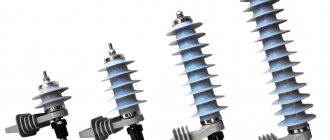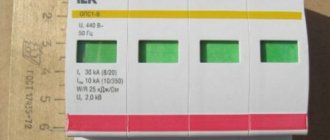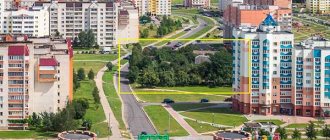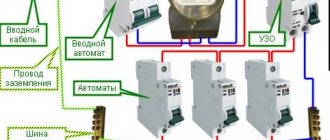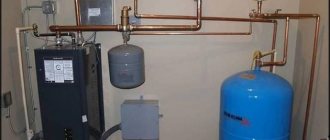Pulse overvoltage is a short-term sharp increase in voltage in the electrical network. Despite the fact that this surge does not last long (a fraction of a second), it is extremely dangerous both for the line and for the energy consumers connected to it. To prevent damage to cables and electrical devices, surge protection devices are used. In this material we will talk about what these devices are, what types they come in, and also consider how SPDs for a private home are connected.
Causes of surge voltage
IP can occur due to both technological and natural reasons. In the first case, a sharp drop in potential difference occurs when a switching overload occurs at the transformer substation from which the power supply for a particular line comes. Pulse overvoltage caused by natural causes occurs when, during a thunderstorm, a powerful discharge strikes the lightning protection of a structure or an electrical transmission line. Regardless of what causes a power surge, it can be very dangerous for your home electrical system, so to effectively protect against it, you need to connect a surge protector.
Lightning protection device: are there instructions?
Unfortunately, for some reason there are still no official standards stipulating recommendations and requirements for lightning protection devices for private homes. In each case, designers and homeowners must rely on common sense and the experience of electricians. The only practical advice that needs to be followed strictly: think about lightning protection as early as possible, even at the stage of designing a house and laying the foundation. In individual residential buildings, lightning protection is finally installed at the stage of distributing electricity throughout the house.
Why do you need to connect an SPD?
In order to protect the electrical network and the devices connected to it from powerful current pulses and sudden voltage changes, a device is installed to protect the line and equipment from pulse voltages (abbreviated as SPD). It includes one or more nonlinear elements. The connection of the internal components of the protective device can be made either in a certain combination or in various ways (phase-phase, phase-earth, phase-zero, zero-earth). In accordance with the requirements of the PUE, the installation of an SPD to protect the network of a private house or other separate building is carried out only after the introductory circuit breaker.
Visually about the SPD in the video:
Installation of the protective circuit
Lightning rods of different types
Lightning protection in a private home can easily be installed independently. In this section I will tell you what parts it consists of, and I will start with the most important one - the lightning rod.
It is a metal element that takes the first blow and ensures that the charge is captured. Thus, instead of causing damage, lightning energy is redirected to the ground loop.
The lightning rod can have different designs. I will briefly describe the most common types in the table:
Types of SPDs
These devices may have one or two inputs. Both single-input and double-input devices are always connected in parallel to the circuit they protect. In accordance with the type of nonlinear element, SPDs are divided into:
- Commuting.
- Limiting (mains voltage limiter).
- Combined.
Switching protective devices
Switching devices in normal operating mode are characterized by high resistance. When there is a sharp increase in voltage in the electrical network, the resistance of the device instantly drops to a minimum value. The basis of network protection switching devices are arresters.
Network surge suppressors (OSV)
The surge suppressor is also characterized by a high resistance, gradually decreasing as the voltage increases and the electric current increases. A gradual reduction in resistance is a hallmark of limiting SPDs. The mains overvoltage limiter (OSL) has a varistor in its design (this is the name of a resistor whose resistance value is nonlinearly dependent on the voltage acting on it). When the voltage parameter becomes greater than the threshold value, there is a sharp increase in the current passing through the varistor. After smoothing out the electrical impulse caused by a switching overload or lightning strike, the mains voltage limiter (SVR) returns to its normal state.
Combined SPDs
Combined type devices combine the capabilities of switching and limiting devices. They can both commute the potential difference and limit its increase. If necessary, combined appliances can perform both of these tasks simultaneously.
Tips for using the system
To ensure that lightning protection is in good condition, it is recommended to adhere to a number of rules:
- After winter ends, check all system components to ensure they are able to perform their functions.
- Monitor the appearance of traces of corrosion on the metal. If necessary, replace parts with new ones.
- Once every two to three years, paint the lightning protection elements and clean the contacts. If necessary, tighten the wire to prevent it from sagging.
- Every five years, open the grounding for the purpose of preventive inspection and maintenance.
Classes of IP protection devices
There are 3 classes of line surge protection devices:
Class I devices are installed in a distribution board or incoming cabinet and allow you to protect the network from surge voltage when an electric discharge hits a power line or lightning protection during a thunderstorm.
Class II devices provide additional protection for the electrical line from damage caused by lightning strikes. They are also installed when it is necessary to protect the network from surges caused by switching. They are installed after class I devices.
Video about SPD from ABB specialists:
Class I+II devices provide protection for individual residential buildings. These devices are installed near electrical equipment. They play the role of the last barrier, smoothing out the residual overvoltage, which, as a rule, is of insignificant magnitude. Devices of this class are produced in the form of specialized electrical sockets or plugs.
The simultaneous installation of class I, II and III devices guarantees three-stage protection of the electrical line from surge voltage surges.
Is it possible to do without a lightning rod?
In no case! For several reasons.
- The probability of lightning striking a house, although small, still exists. Especially if the building rises above all others, is located on the top of a hill or on the shore of a reservoir.
- A direct lightning strike is not the only danger during a thunderstorm. Lightning strikes within a radius of 200-500 meters are also dangerous for the electrical circuit of a house and the equipment connected to it: they cause severe electromagnetic disturbances. Lightning overvoltages, which appear due to rapid changes in the electromagnetic field during a thunderstorm, can also damage equipment.
- The absence of a lightning rod may result in refusal to pay insurance compensation in the event of a fire.
How to connect an SPD in a private house?
Protective devices can be connected to household electrical networks (with one phase and operating voltage 220V) and to current-carrying lines of industrial facilities (three phases, 380V). Based on this, the complete SPD connection diagram provides for the effect of the corresponding voltage indicator.
If the role of grounding and neutral conductor is played by a common cable, then in such a circuit a simple single-block SPD is installed. It is connected as follows: a phase conductor connected to the input of the protective device - an output cable connected to a common protective conductor - the protected electrical appliances and equipment.
In accordance with the requirements of modern electrical documentation, the neutral and grounding conductors should not be combined. Based on this, in new homes, to protect the circuit from voltage surges, a two-module device is used, which has three separate terminals: phase, neutral and ground.
In this case, the device is connected to the circuit according to a different principle: the phase and neutral cable go to the corresponding terminals of the SPD, and then in a loop to the equipment connected to the line. The grounding conductor is also connected to its terminal of the protective device.
In each of the cases described, the excessive current generated by the overvoltage flows into the ground through the ground cable or common protective conductor without affecting the line or the equipment connected to it.
Answers to questions about SPDs in the video:
Thunderstorm, lightning and do-it-yourself power grid protection
As a result of the May thunderstorms, it was necessary to conduct an audit of the burnt equipment, and although the damage was not so great financially, the failure of some equipment disrupted the established comfort of living in one’s own home. So I decided to turn to specialists in my field, consult and expand the protection system. Initial data: house, 3 phases (15 kW per house), grounding with a 3 m long pin, autonomous electrical system based on solar panels
The photo shows the result of a short circuit on the side of the 10 kV line. The protection did not work at the district substation. This is what the input panel looks like from the 0.4KV side. The 100A IEK circuit breaker was unable to break the arc between the jaws. Further along the line there was a HYBRID 9kW 48V MAC. We got off with a slight fright: the varistor was changed in the inverter, after which the MAC came back to life, however, the RS232 port stopped working normally. That is, a serious accident at a substation, which burned a 100 Ampere automatic fuse, affected the inverter only with a burned-out varistor and errors on the controller, and all other functionality of the device was preserved, as well as all the equipment connected after it - a praiseworthy job.
And below in the photo is the metering unit from the 10 kV side
This accident did not happen in my house, but these photographs were given to me by specialists from the MicroART company. At one time, I decided to switch to equipment from a Russian manufacturer for my hybrid solar-grid electrical system and described these devices here and here. I had the following case: during a thunderstorm, lightning struck my substation or nearby, as a result of which the protection at the entrance to the house worked. The result of that thunderstorm was a burnt-out battery charger, connected to the network at the time of the thunderstorm, a burnt-out ventilation automatic relay (the relay was powered from the line that was supported by that same charger), and the MAC Hybrid 4.5 kW inverter began to flash its screen and stopped generating. After the storm, restarting all systems returned power to the house, the inverter started without problems, and I started thinking about seriously protecting the home electrical network.
A little theory
During a thunderstorm in an ordinary apartment or office building, the protection installed by the stationary electrical network must work. In a cottage community, village or dacha, protection is usually limited to a buried ground at the substation and a fuse that disconnects the entire network from operation. Moreover, according to the connection rules, grounding must also be installed on every second pole and separately on the final one, where the subscriber house is connected. Having walked through my village and examined more than fifty pillars, I did not find a single grounding connection, which means I can only rely on myself.
The second “killing” factor is induced electricity. During lightning, there is a fairly powerful surge of EMR, and the house wiring is essentially a large antenna. The closer the lightning, the greater the likelihood of a power surge in the internal network. Installers of home local networks have constantly encountered and continue to encounter this phenomenon, when switches without grounding, during a thunderstorm, burn out in entire chains.
So, we need to protect ourselves from an external impulse that can come from a substation and from an internal surge that can occur during lightning near the house.
Practice
Lightning rod
If your house is located on a hill, far from any buildings and is the highest point in the area, then it is better to take care of a lightning rod. This device is reliable, but it is necessary to clearly calculate the coverage area. There is a lot of material on this topic on the Internet. I will only say that the effect of a lightning rod extends in a cone from the highest point to the ground. To “cover” the entire house, you need to install either two lightning rods with a metal cable between them, or one, but quite high. If the lightning rod is grounded separately from the general grounding, then it is necessary to use a potential equalization system.
Excerpts from the INSTRUCTIONS FOR LIGHTNING PROTECTION OF BUILDINGS AND STRUCTURES RD 34.21.122-87: “As lightning protection grounding conductors, it is allowed to use all electrical installation grounding conductors recommended by the PUE, with the exception of the neutral wires of overhead power lines with voltages up to 1 kV.
„ “2.5. To prevent the introduction of high potential into the protected building or structure through underground metal communications (including through electrical cables for any purpose), grounding conductors for protection against direct lightning strikes should be, if possible, removed from these communications at the maximum distances allowed by technological requirements. „
Entering the network into the house
The danger of introducing high voltage is terrible not only during a thunderstorm, but also when wires overlap on poles or there is a large phase imbalance. It is common for rural electrical networks when the phase voltage can be 180, 200 and 240 V. GOST allows power supply with a voltage deviation of up to 10% (more precisely, +10% and -15%) from the norm of 220 V, that is from 187 to 242 V. But not all supplied equipment can withstand such voltage drops. For normal protection, it is best to use voltage stabilizers. Moreover, there are three-phase and single-phase stabilizers. Most often, three single-phase stabilizers will work better than one three-phase one, if only because the simplest devices monitor the voltage in one phase and the change (increase or decrease) in voltage occurs in all three. Simplified: when the voltage rises from 180 to 220 V, the voltage in the other phase will increase from 210 to 250 V, which is fraught with damage to the equipment. Therefore, tracking each of the phases will be more reliable. In addition, several types of stabilizers can be distinguished:
- LATR
- Relay
- Triac
First
has high voltage setting accuracy, since the motor slides the carrier along the windings and sets the desired voltage.
Pros: low price, high accuracy of output voltage. Cons: low response speed to voltage surges, physical wear and tear of the mechanics The second
has an increased switching speed of the transformer windings, but since powers can reach tens of kW or more, the relay contactors wear out and sooner or later they can stick, which will lead to dire consequences.
Pros: affordable price, sufficient switching speed. Cons: insufficient reliability due to the use of mechanical relays. The third
type is the most interesting, but also the most expensive. The use of powerful switches allows you to instantly respond to changes in input voltage and switch the transformer windings. There is simply no physical wear, as well as sticking of contacts. In addition, switching occurs when the sine passes through zero, so jumps are also excluded. Pros: high response speed, lack of physical wear. Cons: high price.
For myself, I chose a more expensive, but also more reliable option, a triac-controlled stabilizer CH-LCD “Energy” 6 kW. Since I already have a 4.5 kW inverter, which at peak can output up to 7 kW, it was decided to choose a stabilizer with a rated power of 6 kW and the ability to output up to 7.4 kW at peak.
You can read in detail about the operating features of these stabilizers and what kind of stabilizers there are in general here.
Well, I was interested in taking it apart and seeing what was inside. Opening the stabilizer showed
As can be seen from the photo, the stabilizer uses a toroidal transformer, which, with the same dimensions as the W-shaped one, has greater efficiency and less weight. The transformer itself is manufactured in Tula, and the stabilizer is designed and assembled in Moscow. Thus, we can safely declare a completely Russian production, which the MicroART company managed to organize and maintain.
So, I protected myself from voltage sags and rises in the range of 125-275 Volts, but what if there is a sudden voltage surge that goes far beyond these limits? The inverter once showed me 287 V in phase, after which it went into defense. But apply 380 V to it and it will simply burn out, like the stabilizer. I wanted to protect expensive equipment. Some kind of release was required that would turn off the external network at threshold voltage values. It’s better to be left without a network than to repair or replace burned-out equipment later. A solution was found - the mains voltage control relay UZM-51M1.
This device is designed to ensure single-phase operation, while you can manually set the upper and lower voltage thresholds at which the relay will operate. The shutdown time is about 20 ms, which is a very good indicator. At the same time, small sags or some voltage overvoltage will not cause an immediate shutdown, but the shutdown timer will start. When the parameters return to normal, the relay will independently connect the load to the network. So, home devices are protected from fluctuations and surges in the external power supply using a voltage control relay and stabilizer. If the network disappears, the inverter starts working. What to do if the external network is already turned off, lightning strikes nearby and the house wiring works like an antenna?
Internal network protection
We will assume that all sockets are correctly wired, grounding is done properly and excess charge flows into the ground. But a power surge in the internal network easily destroys all equipment, since all protections are in place to protect against external surges. But there is nothing from internal interference. With this thought, I turned to MicroART engineers when I was picking up the stabilizer and they recommended a “Device for protection against lightning and interference” - SPD.
This is a kind of spark gap that, when a critical voltage appears between the phase and the ground, passes a pulse through itself, sending it to grounding. That is, during a thunderstorm, when lightning strikes nearby and the voltage in the home network rises to several kilovolts along the phase wire relative to the ground and exceeds a certain value, this SPD will simply release the entire charge into the ground. Therefore, it is placed in front of the inverter, one end connected to the phase and the other to ground. It is worth considering that the discharge can be significant, so you should not skimp on the cross-section of the grounding wire, otherwise the resistance of the wire may turn out to be critical and there will not be time to transmit the impulse to the ground.
This is how the connection to the external network and generator is made:
I already mentioned that I have an off-grid solar powered system. A serious impulse can also come through the wires coming from the solar panels, disabling the solar controller, and then the inverter. Therefore, I also hung an SPD on each of the wires from the solar panels.
Generator protection
In the most emergency case, when there is no external network, the sun is not visible, and the batteries are already dead, all autonomous drivers have a backup option - a gas/diesel generator. It will allow your home network to function, operate a powerful tool yourself, and even recharge the batteries. I described a similar redundancy topology in my material here. The problem with this connection is that most generators produce extremely unstable and noisy power. Sometimes inverters or chargers simply cannot work with such power. There is a special surge filter to suppress interference. You can get by with a standard “pilot”, but it is usually designed for a power of up to 2-3 kW, and the generator often consumes more. So, I also found an EMP (electromagnetic pulse) filter: EMP Suppression Surge Filter.
It can handle power consumption up to 11 kW, which is enough to power an entire house if you have a powerful generator. It has a through connection and a separate contact for grounding.
Results of the work carried out
The result of one thunderstorm and small losses was a rethinking of methods of protection, both from external energy collisions and from internal ones. In addition, the protection of all electrical appliances in the house has increased, both from voltage surges and from sudden surges and impulses. The autonomy has been further increased by connecting the generator through a filter, which guarantees a stable charge of the batteries and normal operation of the inverter. As a result, the electrical system changed. Before:
This is what happened AFTER installing the protection:
The generator connection diagram is quite simple. Any of the wires is combined with the existing ground and zero brought into the house. The second wire then becomes a phase. It is important to choose a switch that will prevent the simultaneous short circuit of the generator phase and the phase from the substation.
The first launch of the entire system looked like this:
Alternative lightning protection devices
A modified and more reliable lightning protection system compared to pins is a cable lightning protection system. Two small pins are installed on the roof ridges, with a bare wire running between them. The entire structure serves as a current collector.
Another option is used on city buildings - lightning protection network . This is a metal mesh with large cells laid over the entire roof area. The wires are usually hidden in the concrete roof screed. This technology is also suitable for small private houses, but with an amendment: it is recommended to lay the wires on top of the roofing material, otherwise the roof will have to be repaired after a lightning strike.
Important: the lightning protection network is used only on non-metallic roofing! There should be no metal parts outside the network, including drains.
Concept and main functions of protection
What a lightning rod is is subconsciously clear to any person. In essence, it is a device for protecting various types of buildings from lightning strikes. It is most often presented in the form of a pointed metal pin mounted vertically on the roof of a building or on a nearby mast that rises above the building. The lower end of this pin is connected to ground (a circuit in the ground) using a conductor.
The principle of operation of a lightning rod is to transfer the main electrical charge of lightning using a conductor into the ground and then dissipate it there, preventing damage or fire to the building.
Installation of devices in the main switchboard
Most surge protectors are modular and can be installed on a 35 mm DIN rail. The only requirement is that the shield for installing the SPD must have a metal casing with a mandatory connection to the protective conductor.
When choosing an SPD, in addition to the main performance characteristics, you should also take into account the rated operating current in bypass mode; it must correspond to the load in your electrical network. Another parameter is the maximum limiting voltage; it should not be lower than the highest value within the daily fluctuations.
SPDs are connected in series to a single-phase or three-phase supply network, respectively, through a two-pole and four-pole circuit breaker. Its installation is necessary in case of soldering of the spark gap electrodes or breakdown of the varistor, which causes a permanent short circuit. The phases and protective conductor are connected to the upper terminals of the SPD, and the neutral conductor is connected to the lower terminals.
SPD connection example: 1 – input; 2 - automatic switch; 3 - SPD; 4 - grounding bus; 5 - ground loop; 6 - electricity meter; 7 - differential automatic; 8 - to consumer machines
When installing several protective devices with different protection classes, their coordination is required using special chokes connected in series with the SPD. Protective devices are built into the circuit in ascending order of class. Without approval, more sensitive SPDs will take the main load and fail earlier.
